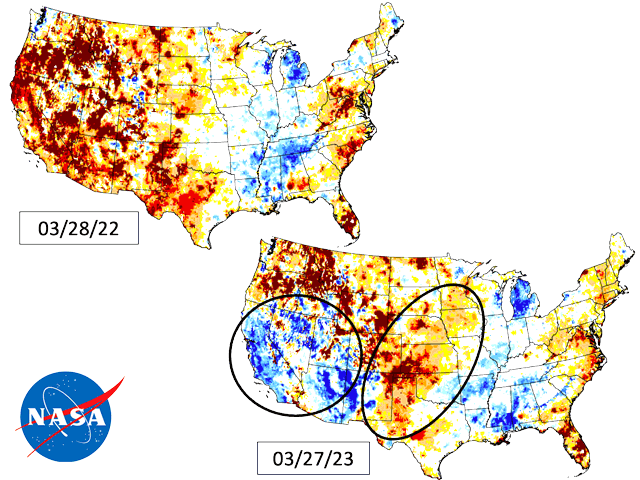Ag Weather Forum
Changes and Challenges in Spring Soil Moisture Review
A look at root zone soil moisture from the space and computer wizardry combination at the NASA Goddard Space Flight Center shows some obvious and possibly some surprising changes compared to last year as spring 2023 unfolds.
Some definitions are in order here. The moisture analysis project is titled the NASA GRACE program. GRACE stands for "Gravity Recovery and Climate Experiment." The project dates to 2002 when scientists from the U.S. and Germany collaborated in developing this project. The analysis effort is now run by the National Drought Mitigation Center at the University of Nebraska-Lincoln. The root zone is defined as the top 1 meter of soil -- approximately 39.4 inches or the top 3 feet of the soil profile.
There is no doubt that moisture is much more plentiful in the West than a year ago; after all, the California state climate office has identified 25 atmospheric river events which affected California during the past winter and this spring. Root zone moisture is approaching the top end of the long-term benchmark period from 1948 to 2012. Of course, we know that flooding from these heavy precipitation events is already a major problem, with more water on the way in the form of melting snow from the Sierra Nevada mountains. The snow water equivalent in the Sierra Nevada mountains, as of April 5, generally ranged from 50 to 70 inches -- around twice the median amount.
P[L1] D[0x0] M[300x250] OOP[F] ADUNIT[] T[]
In the western Midwest and the Central and Southern Plains, the story is different -- and much drier. Almost all of Nebraska, Kansas, eastern Colorado, western Oklahoma and the Texas Panhandle have root zone moisture analyzed in no higher than 25% of the 1948-to-2012 average. That's not a big surprise following a very dry 2022, when drought and heat slashed winter wheat production and pulled the rug out from under row crop yields as well in these states and portions of states.
But what is surprising and possibly underappreciated is a lack of root zone moisture in the western Midwest. The NASA analysis in early April finds much of Iowa, northern Missouri and western Illinois in the lower half of the long-term spectrum when it comes to root zone moisture. That's different than a year ago, when western Iowa had some dryness, but the remainder of the state was near the long-term average when it came to the root zone moisture supply.
This rundown of crop moisture availability puts greater emphasis on the performance of spring season rainfall in the central U.S. The drier soils in the western and southern crop areas may have a challenge in supporting early crop growth without some supplement, because there's little available moisture to begin with. In the north and west, the question is how much acreage will go unplanted this year with the potential for snow-melt flooding and long-lasting saturated ground.
Bryce Anderson can be reached at bryce.anderson@dtn.com
Follow him on Twitter @BAndersonDTN
(c) Copyright 2023 DTN, LLC. All rights reserved.




